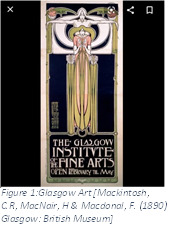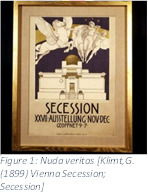Various modernist artistic movements of the 20th century.
Don't wanna be here? Send us removal request.
Text
2. ART NOUVEAU
It is a decorative style of workmanship that thrived somewhere in the range of 1980 and 1910 all through Europe and US. It is described by its utilization of long, crooked, natural line and was utilized frequently in engineering, inside structure, gems and glass plans, blurbs and deceptions. Craftsmanship Nouveau has seen a recovery over the most recent 20 years with the ascent of postmodernism structure. Craftsman everywhere throughout the world use components of this cutting edge workmanship style as a motivation. Such components incorporate twisted lines, flower component, nature highlights and the trademark hues.
19th to 20th Century
The furniture pieces had a round twisted and rich lines. The furniture was made out of wood and normally joined with glass and metal. Some furniture pieces flaunted embroidered artwork and a mode flower designs. The cupboards normally had numerous drawers and painted glass.
21st Century
The Craftsmanship Nouveau style is as yet found in a portion of the present rich homes. The home structures in craftsmanship nouveau style are described by the utilization of different prints and fancy prints. These are utilized in designing the dividers or embroidered artwork in materials or workmanship relics or divider watches.

The extras are spoken to by enormous mirrors with bronze edges or etched wood, painted gems cases, containers and porcelains.
REFERRENCE: Jirousek, C. 1995. Arts and craft movement; Arts, Design and Visual thinking. Accessed on 31/08/19. URL: http://char.txa.cornell.edu/art/decart/artcraft/artcraft.htm
3. GLASGLOW SCHOOL
Glasgow School was a hover of persuasive craftsman and planners that started to mix in Glasgow, Scotland during the 1870s and thrived from the 1890s to around 1910. In 1980s Scotland, Charles Rennie Mackinton, Herbert McNair, and Margaret and Frances Macdonald ended up noticeable figures in a craftsmanship development called the Glasgow school. Their wellsprings of data included early medieval compositions and metal work. The publication demonstrates their qualities extended figures and in vogue blossoms.

Cushion cover, Jessy Newbery, around 1900. The Scottish school was a gathering of craftsmen and planners who built up another and strikingly style in 1880s, they worked in Glasgow and Edinburgh making beautifying plans in which engineering, inside structure, furniture and fittings blended. They meant to deliver articles and situations that were fit to contemporary cosmopolitan life. The Scottish school style was in vogue from 1885 to 1915.
REFERRENCE: Walton, E.A. 1884. Tate; Glasgow School . Accessed on 31/08/19. URL: https://www.tate.org.uk/art/art-terms/g/glasgow-school
4. VIENNESE SECESSION
The Viennese Secession was a craftsmanship development shaped in 1897 by a gathering of Austrian craftsmen. This development incorporates painters, figures and planners.
Gustav klimt encircled his Nuda Veritas (1899). He made an intense image of the Vienna withdrawal and communicated its creative insubordination.

The most recent is craftsmanship by Beethoven Frieze (1902). It was painted on the inside dividers of the withdrawal building, it was protected however was not shown again until 1986 and it is presently for all time on view in the storm cellar. The image additionally propose their craving to orchestrate a contemporary craftsmanship from old and new, development and custom, which reacts to the expectations and wants of contemporary society.
REFERRENCE: Olbrich, J.M. 1897. The Art Story; Vienna secession. Accessed on 31/08/19. URL: https://www.theartstory.org/movement/vienna-secession/
5. FUTURISM
It was a creative and social development that began in Italy in the mid-20th century. Cubism added to the data of Italian futurism's creative style.
Craftsmanship by Gino Severini (1912). It underscores speed, innovation, youth, brutality and articles, for example, vehicle, the plane and the mechanical city.

Neo Futurism is a late twentieth to mid-21st century development in human expressions, plan and design. It could be viewed as take-off from the mentality of post-innovation and speaks to a hopeful faith in a superior future and a need to periodize the cutting edge affinity with the mechanical. Concentrating on advancement and innovation, the futurists looked to clear away customary creative ideas and supplant them with a fiery festival of the machine age.
REFERRENCE: Boccioni, U. 1910. The Art Story; Futurism. Accessed on 31/08/19. URL: https://www.theartstory.org/movement/futurism/
6. EXPRESSIONISM
It rose all the while in different urban communities crosswise over Germany as a reaction to a wide spread tension about mankind's inexorably dissonant association with the world and going with lost sentiments of genuineness and profoundly. Expressionism was propelled most vigorously by the symbolist flows in late 19th century craftsmanship.


Communicated in his composition is The Scream (1893), his accentuation upon exceptional inward experience set the way for expressionism, characterized by Ernst Kirchner as reflecting "the impressions of a man within recent memory."
Expressionism is an innovator development, at first in verse and painting, starting in Germany toward the start of the 20thy century. Its regular quality is to show the world exclusively from an abstract viewpoint, contorting it drastically for enthusiastic impact so as to summon mind-sets or thoughts.
This 1920 painting is the most recent called the "Mad woman", This canvas typifies the quintessence of expressionist style, Mad woman unmistakably vibrates, reshapes, moves, pushes and pulls, furnishing the watcher with Soutine's vision of the internal torment of his sitter.
REFERRENCE: Picabia, F. 1893. The Art Story; Expressionism. Accessed on 31/08/19. URL: https://www.theartstory.org/movement/Expressionism/
7. DADA
Dadaism was a craftsmanship development of the European cutting edge in the mid twentieth century.

Mona Lisa's artwork (1917) was changed by Duchamp. While it was at that point an outstanding gem, the attention from the robbery guaranteed that it wound up one of the most worshipped and popular centrepieces. On the postcard he drew a moustache and a goatee onto Mona Lisa's face.
The most recent is by beam 1922. His revelation of the rayography was its self-dependent on possibility, after he had neglected to uncover a picture and was holding on to show up in obscurity room, he set a few items on the photograph paper. After observing them, Tzara called them “pure dada creations” and they were a moment hit among the same disapproved of craftsmen. While man Beam did not imagine the photogram, his were the most celebrated.
REFERRENCE: Picabia, F. 1915. The Art Story; Dada. Accessed on 31/08/19. URL: https://www.theartstory.org/movement/dada/
8. SURREALISM
It is a social development that started in the mid-1920s and is best known for its visual works of art and compositions.
Inventive masterminds have consistently played with the real world, however in the mid twentieth century surrealism developed as a thoughtful and social development. Fuelled by the lessons of Freud and the defiant work of Dada craftsman and writers. Visual craftsman, artists, writers, arrangers and producers searched for approaches to free the mind and tap shrouded supplies of innovativeness.
Numerous craftsman on the planet are affected by surrealism styles, thought and systems. It's simple for a craftsman to
demonstrate their imagination through surrealism, on the grounds that the style gives them more opportunity to pass on their sentiments and contemplations through the canvas. Dreamlike craftsmanship can be marvellous or abrasive or it very well may be idealistic or discouraging.

REFERRENCE: Masson, A. 1976. Art Gallery; surrealism. Accessed on 31/08/19. URL: https://www.artsy.net/article/artsy-editorial-what-is-surrealism
0 notes
Text
Art and Craft Movement
The development rose during the late Victorian time frame in Britain. The architects looked to improve models of enhancing plans, accepted to have been degraded by automation and to make situations in which wonderful and fine workmanship represented.
Southwestern Native American artefacts, for example, mats, stoneware, and bins. The gathering of Southwestern curios turned out to be extremely famous in the primary quarter of the twentieth century.
Basket weaving is one of the most seasoned and most huge specialties of Local American societies. The significance of crates in religious functions and as a customary segment of the Local American family unit, has kept the convention of container weaving alive.
Native Americans have carefully assembled crates for a considerable length of time and keep on utilizing a significant number of the conventional materials and procedures in present day weaving. A portion of the materials utilized are occasional and just found in explicit districts. It isn't exceptional for weavers to go numerous miles to acquire certain materials for their weaving ventures. Willow, yucca, cattails, fiends paw, horsehair and grasses are ordinarily utilized materials. Enrichment of rawhide tufts with dabs, quills and different trimmings connected are some of the time added to the bins for special visualization or to help in usefulness of the bushel.
To assess a reasonable cost and nature of a container, you should take a gander at the fineness of the weave, multifaceted nature of plan, balance, and kind of materials utilized and the size of the crate. A few materials, for example, willow, set aside more effort to plan and weave, which will yield a higher estimated bushel.

Clay rice dish which was propelled with winged serpent design 1898, the dish was made by William de Morgan, a potter who was motivated by Morris and his thoughts. Morris had faith in top notch materials and great yet not excessively entangled plan.
REFERRENCE: Jirousek, C. 1995. Arts and craft movement; Arts, Design and Visual thinking. Accessed on 31/08/19. URL: http://char.txa.cornell.edu/art/decart/artcraft/artcraft.htm
1 note
·
View note